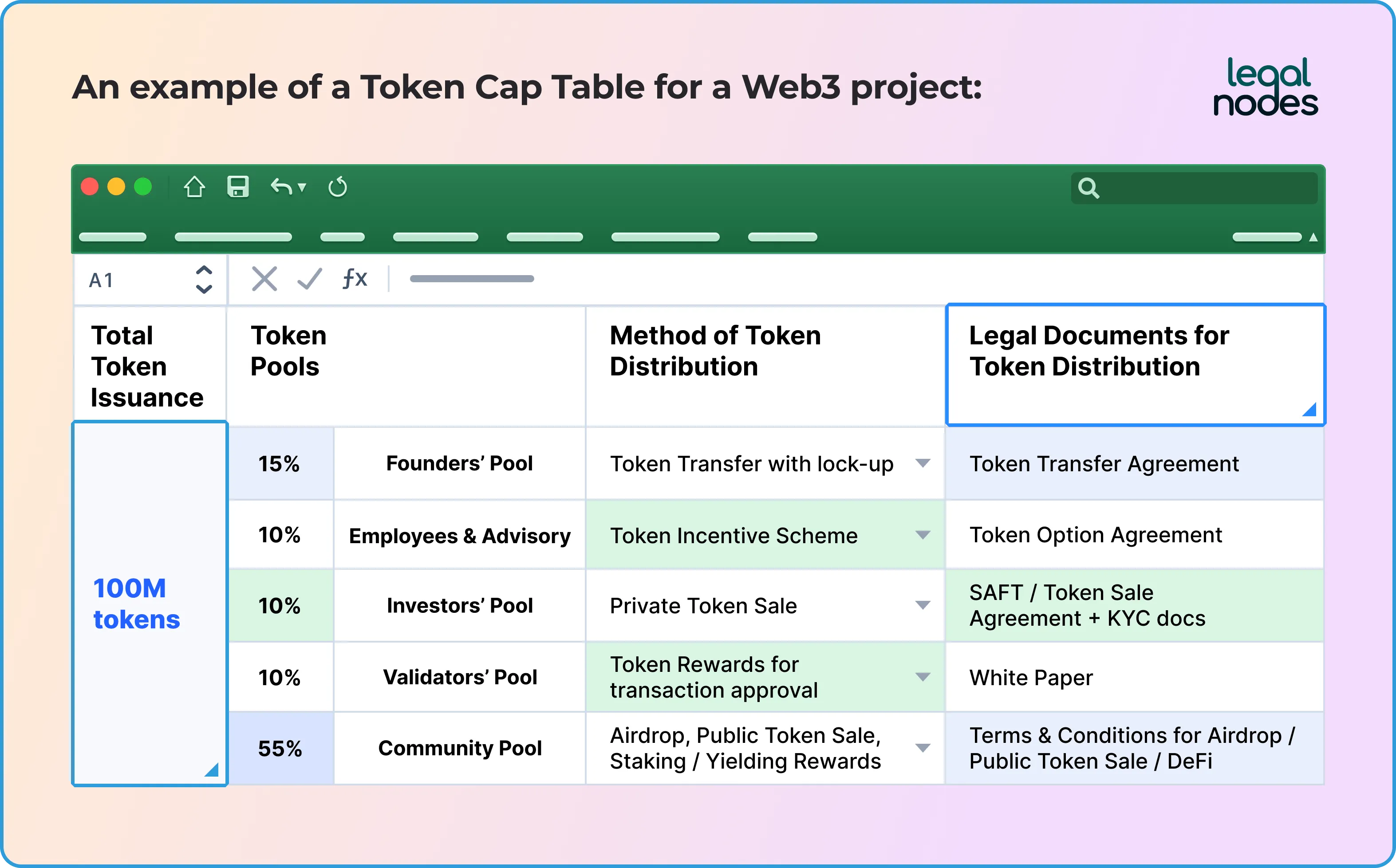What is a Token Cap Table?
A Token Cap Table is an essential component of any tokenomics. It contains information about the total token emission and the division of tokens into different pools and explains the distribution methods.
This information, similar to an Equity Cap Table in traditional (Web2) startups, is usually presented in the form of a table. A Token Cap Table is instrumental for determining the company valuation because investors use it to decide on the investment amount and calculate the expected number of tokens.
🏴 Not sure where to begin with the legal aspect of your token distribution? Check out our latest playbook to get started: How to Build a Legal Strategy for a Token Project in 2024
What types of token pools can be included in a Token Cap Table?
We can categorize token pools into two groups:
- default token pools, which are present in practically all Web3 projects "by default"; and
- custom token pools that are reserved for specific participants of the project's ecosystem.
Default token pools include the following:
- founders' pool – tokens reserved for the founders of the Web3 project;
- team & advisory pool – tokens for employees and advisors;
- investors' pool – tokens for fundraising; and
- community pool – tokens for the community members, such as ambassadors, users, contributors, creators, etc.
Examples of custom token pools:
- validators' pool – tokens for transaction validators in the blockchain protocol;
- oracles' pool – tokens for oracles validating cross-protocol transactions; and
- liquidity pool – tokens that are used in smart contracts in DEX, DeFi, and token swaps, which provide liquidity to those services to make it possible to exchange one virtual asset into another.
How do you distribute different token pools?
Each token pool has its final recipient and a distribution method. For the founders' and team pools, this is often the allocation (reservation) of tokens via Token Options with vesting. SAFTs or private token sales are the preferred distribution mechanism for the investors' pool. Tokens for the team and investors are sometimes also subject to a lock-up, a prohibition on selling the tokens for some time after the execution of the Token Option or SAFT conversion.
You can distribute the community pool via channels such as airdrops, launchpads, public token sales, staking rewards, etc.
Here's an example of a Token Cap Table for a Web3 project:

📚 Read more: Models of Token Distribution and How to Structure Them Legally
Why is a Token Cap Table important for Web3 projects’ fundraising?
There are three reasons why a Token Cap Table is vital for your Web3 project's fundraising:
- investors want to know how the project's tokenomics will work. The Token Cap Table is a key component of Tokenomics and therefore has a big impact on it;
- investors want to know the valuation of the Web3 project, which is later reflected in the SAFTs/SAFTEs. It is impossible to determine a valuation without knowing both the total token emission and its allocation across different pools; and
- investors want to understand how you legally structure the token distribution from different pools (this is often a part of the investor's Due Diligence).
The final point is closely related to choosing the proper jurisdiction for a Token Issuer Company incorporation. You need to understand the regulatory requirements imposed on the distribution of each token type because these requirements affect the legal documents you'd need to use for the distribution and the requirements for token purchasers' verification.
📚 Read more: How to Prepare Web3 Startup for Fundraising
How to get help with structuring your Web3 project
Although structuring your Web3 project might seem hard, it's quite simple if you follow the best practices that we distill in our Web3 resources center.
If you're at the point where you need help with the legal structuring of your Web3 project, Legal Nodes
Disclaimer: the information in this article is provided for informational purposes only. You should not construe any such information as legal, tax, investment, trading, financial, or other advice.
Nestor is a Co-founder & Head of Web3 Legal at Legal Nodes. Having over eight years of legal consulting experience, Nestor loves working with innovative startups and Web3 projects, helping them navigate the regulations and scale on global markets.
